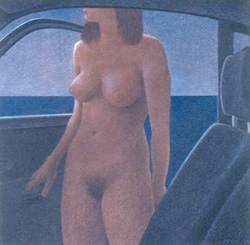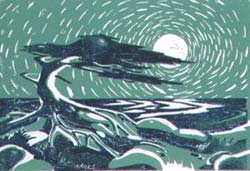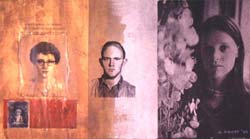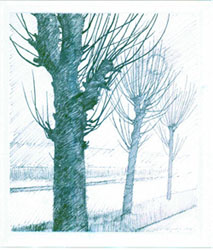|
Aside from works done
by painting, silkscreen printing and lithography, Christopher Pratt often
works in other media. These media types all have their own processes which
are explained below.
|
Mixed
Media
 Christopher Pratt often works in what is known as mixed media. A good
deal of mixed media work has been completed by Pratt recently, especially
during the period shortly after the fire that destroyed his studio
in 1992. Mixed media is not so much a medium in its own right as a
combination of different types of media. This should not be confused
with collage. For example, Above
Gander Lake (1997) is a mixed media work made with a lithographic
image (the trees and scenery) printed on top of a silkscreened sky.
Because the process of the piece depends on which types of media are
used in the work, there is no one process for mixed media works. Night
Nude: Summer of the Karmann Ghia (1994) is in gouache
and colour pencils over watercolour.
Christopher Pratt often works in what is known as mixed media. A good
deal of mixed media work has been completed by Pratt recently, especially
during the period shortly after the fire that destroyed his studio
in 1992. Mixed media is not so much a medium in its own right as a
combination of different types of media. This should not be confused
with collage. For example, Above
Gander Lake (1997) is a mixed media work made with a lithographic
image (the trees and scenery) printed on top of a silkscreened sky.
Because the process of the piece depends on which types of media are
used in the work, there is no one process for mixed media works. Night
Nude: Summer of the Karmann Ghia (1994) is in gouache
and colour pencils over watercolour. |
| |
|
Woodcut
and Linocut
 Two
other closely related media in which Pratt has created artworks
are woodcut and linocut prints. Most of Pratt's woodcuts and linocuts
were made in his early career, between 1958 and 1960. These media
are both basic printmaking techniques. In a woodcut, an image is
drawn on a block of wood. After the image is completed, parts of
the block are cut or gouged out using specially designed cutting
tools, leaving only the lines, shapes and areas the artist wants
to print. Using a roller, the block of wood is then covered with
ink or paint and is pressed onto a piece of paper. Aspect
of Point Lance is a woodcut that was made in 1960. A linocut,
like Tree and Moon (1958), is similar to a woodcut,
except for the fact that a block of linoleum is used instead of
wood. Linoleum is an old fashioned flooring material and is softer
and easier to cut than wood and has no grain. Two
other closely related media in which Pratt has created artworks
are woodcut and linocut prints. Most of Pratt's woodcuts and linocuts
were made in his early career, between 1958 and 1960. These media
are both basic printmaking techniques. In a woodcut, an image is
drawn on a block of wood. After the image is completed, parts of
the block are cut or gouged out using specially designed cutting
tools, leaving only the lines, shapes and areas the artist wants
to print. Using a roller, the block of wood is then covered with
ink or paint and is pressed onto a piece of paper. Aspect
of Point Lance is a woodcut that was made in 1960. A linocut,
like Tree and Moon (1958), is similar to a woodcut,
except for the fact that a block of linoleum is used instead of
wood. Linoleum is an old fashioned flooring material and is softer
and easier to cut than wood and has no grain.
Woodcuts and
linocuts can be cut and printed in either bas or relief. In bas,
the image itself is cut out and everything left is inked and printed.
This means that the image will be a negative print. Relief is the
opposite of bas, meaning that everything except the image is cut
or gouged away. This makes a positive image. |
| |
|
Collage
 A
collage (which comes from the French collé, meaning
glue) is similar in some ways to mixed media in that it is a combination
of different materials. However, in collage, physically different
materials are glued or otherwise fastened on top of, or adjacent
to each other, whereas in mixed media different artistic techniques
are used. Pratt does not often use collage, but when he does, it
may be used in a variety of ways. Pratt uses collage both in studies,
like the one for Ocean Racer (1975), and works like
Residue of Fire: Mary, Donna and Me (1998) and
Self Portrait:
Who is This Sir Munnings? (1998), which is classified as mixed
media because it incorporates some collage in addition to painting. A
collage (which comes from the French collé, meaning
glue) is similar in some ways to mixed media in that it is a combination
of different materials. However, in collage, physically different
materials are glued or otherwise fastened on top of, or adjacent
to each other, whereas in mixed media different artistic techniques
are used. Pratt does not often use collage, but when he does, it
may be used in a variety of ways. Pratt uses collage both in studies,
like the one for Ocean Racer (1975), and works like
Residue of Fire: Mary, Donna and Me (1998) and
Self Portrait:
Who is This Sir Munnings? (1998), which is classified as mixed
media because it incorporates some collage in addition to painting.
|
Graphite
or Ink

Pratt also works in many drawing media, primarily graphite (usually
ordinary pencils) and ink. Nearly all of his figure drawings and
many of his studies are made with graphite on paper. Pruned
Trees At Netherlea (1963) is one example of a finished work
done in ink on paper.
|
return to process/media

|


